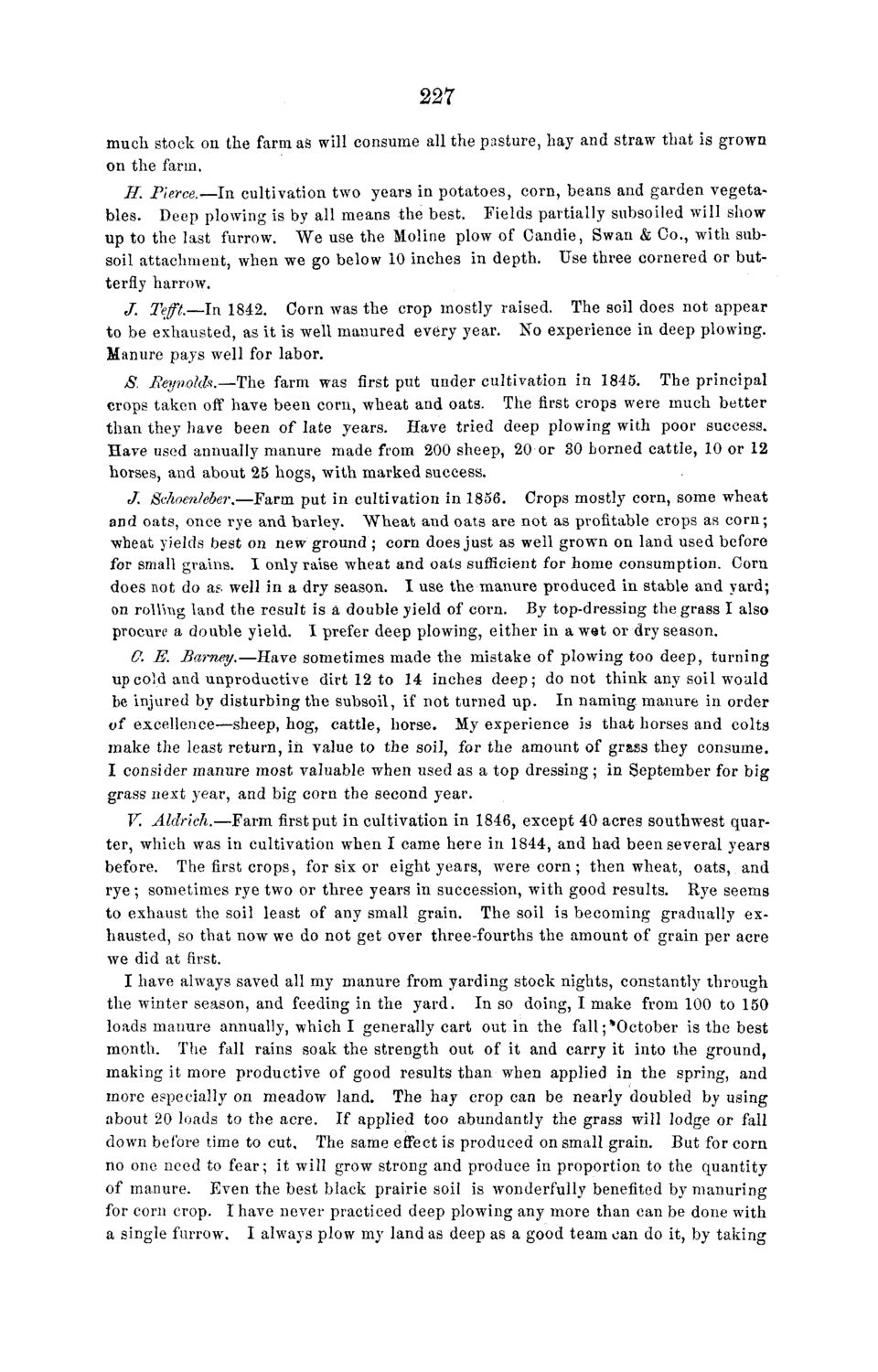| |
| |
Caption: Board of Trustees Minutes - 1868
This is a reduced-resolution page image for fast online browsing.

EXTRACTED TEXT FROM PAGE:
227 much stock on the farm as will consume all the pasture, hay and straw that is grown on the farm. H. Pierce,—In cultivation two years in potatoes, corn, beans and garden vegetables. Deep plowing is by all means the best. Fields partially subsoiled will show up to the last furrow. We use the Moline plow of Candie, Swan & Co., with subsoil attachment, when we go below 10 inches in depth. Use three cornered or butterfly harrow. J, Tefft.—ln 1842. Corn was the crop mostly raised. The soil does not appear to be exhausted, as it is well manured every year. No experience in deep plowing. Manure pays well for labor. S. Reynolds.—The farm was first put under cultivation in 1845. The principal crops taken off have been corn, wheat and oats. The first crops were much better than they have been of late years. Have tried deep plowing with poor success. Have used annually manure made from 200 sheep, 20 or 30 horned cattle, 10 or 12 horses, and about 25 hogs, with marked success. J. Schoenleber.—Farm put in cultivation in 1856. Crops mostly corn, some wheat and oats, once rye and barley. "Wheat and oats are not as profitable crops as corn; wheat yields best on new ground ; corn does just as well grown on land used before for small grains. I only raise wheat and oats sufficient for home consumption. Corn does not do as well in a dry season. I use the manure produced in stable and yard; on roWmg land the result is a double yield of corn. By top-dressing the grass I also procure a double yield. I prefer deep plowing, either in a wet or dry season. O. E. Barney.—Have sometimes made the mistake of plowing too deep, turning up cold and unproductive dirt 12 to 14 inches deep; do not think any soil would be injured by disturbing the subsoil, if not turned up. In naming manure in order of excellence—sheep, hog, cattle, horse. My experience is that horses and colts make the least return, in value to the soil, for the amount of grass they consume. I consider manure most valuable when used as a top dressing ; in September for big grass next year, and big corn the second year. V. Aldrich.—Farm first put in cultivation in 1846, except 40 acres southwest quarter, which was in cultivation when I came here in 1844, and had been several years before. The first crops, for six or eight years, were corn ; then wheat, oats, and rye ; sometimes rye two or three years in succession, with good results. Rye seems to exhaust the soil least of any small grain. The soil is becoming gradually exhausted, so that now we do not get over three-fourths the amount of grain per acre we did at first. I have always saved all my manure from yarding stock nights, constantly through the winter season, and feeding in the yard. In so doing, I make from 100 to 150 loads manure annually, which I generally cart out in the fall ;*October is the best month. The fall rains soak the strength out of it and carry it into the ground, making it more productive of good results than when applied in the spring, and more especially on meadow land. The hay crop can be nearly doubled by using about 20 loads to the acre. If applied too abundantly the grass will lodge or fall down before time to cut. The same effect is produced on small grain. But for corn no one need to fear; it will grow strong and produce in proportion to the quantity of manure. Even the best black prairie soil is wonderfully benefited by manuring for corn crop. I have never practiced deep plowing any more than can be done with a single furrow. I always plow my land as deep as a good team can do it, by taking
| |